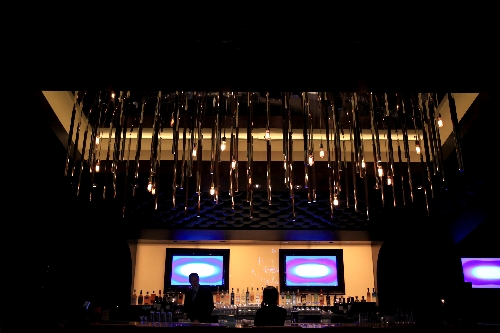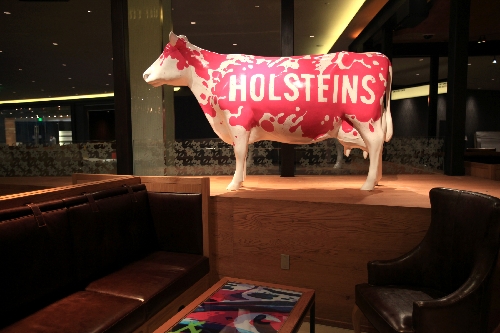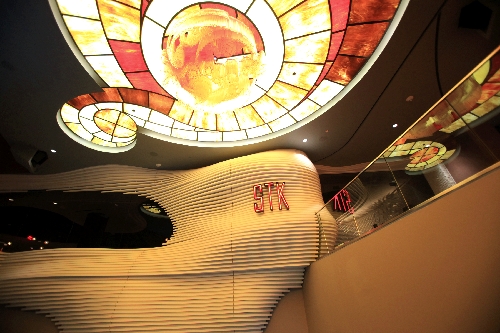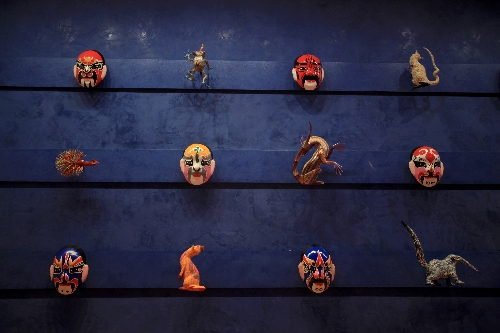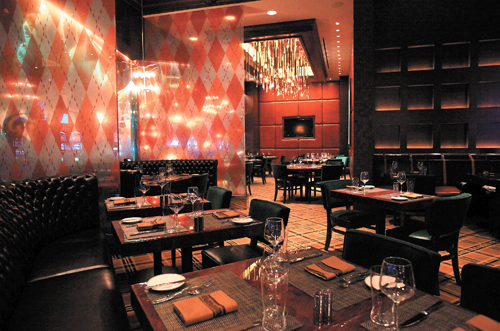Cosmopolitan’s restaurants offer tempting array of cuisines
You won't find any stuffy, gloved-waiter haute-cuisine restaurants at The Cosmopolitan of Las Vegas. You won't find any restaurants by chefs who became household names by dint of their TV cooking shows. What you will find is restaurants designed to appeal to the "curious class," as Chief Executive Officer John Unwin describes his target market.
"The restaurant collection, which is one of our signature elements -- what we think we'll be known for -- is for people who see themselves as creative, broad-minded, who like to explore, enjoy foreign foods and interesting restaurant and hotel concepts," he said.
During the design phase, that translated to, first, a collection of chefs who didn't already have restaurants in Las Vegas, and, second, restaurants that complemented each other. Many of them are grouped on the third floor in an area called the P3 Commons.
"When you walk around on that floor, it really is a neighborhood," Unwin said. There are various seating areas, grouped in vignettes, where Unwin said guests are welcome to "hang out." And all of the restaurant partners belong to a neighborhood improvement district. That came out of Unwin's experience when he first moved to New York and lived in the Times Square area.
"They had an improvement district there, and we all met once a month and tried to figure out what was best for our neighborhood," he said. "It's fun because it's hard to do. Typically, these guys are focused only on their own places. We're doing stuff together. It's like throwing a good party. Having the right mix of restaurants is like having the right mix of people.
"It's really meant to be fun. It's not meant to be pretentious."
What the chefs share, Unwin said, is a passionate dedication to their craft. For Jose Andres, who opened two restaurants -- Jaleo and China Poblano -- with the resort, that extends to spreading the gospel of Spanish cuisine.
"I can't wait to sell this thing to America and the world," he said before the opening.
Jaleo focuses primarily on tapas and paella. While Andres acknowledged that tapas have become somewhat well-known (at least in Las Vegas), in part because of his own restaurants in Washington, D.C., and Los Angeles and the restaurants they inspired, "in Spain, we've been very late in finding the way in how to sell" the country's culinary traditions, he said. "Japan has sushi, Italy has pasta. Spanish tapas is this kind of thing that helps unite Spanish cooking and gives it some identity."
Andres promises some of his signature avant-garde touches -- "no mistake." But he seems truly horrified at the idea of adding other culinary traditions to his tapas lineup, as often is done in this country.
"No, no, no," he said. "Only Spain."
Jaleo also has a specialized paella kitchen, where the traditional dishes will be cooked over olive and orange wood and grapevines, he said.
"I think it's going to be very dramatic," he said. "It's very showy, but in a very arty kind of way."
Another unusual touch at Jaleo, he said, is E, a "restaurant within the restaurant," which has its own chefs and offers a 10- to 12-course Spanish tasting menu to a maximum of eight people.
Andres also opened China Poblano, a noodle-and-taco restaurant that features the culinary traditions of both China and Mexico -- a combination he doesn't find offbeat.
"You could argue that America is the melting pot," he said. "I've been eating in America for 20 years."
Beyond that fusionistic tradition, he said, he's a student of history and knows that China and Mexico long have had elements of cross-pollination.
"To me, the connection is fascinating," he said. "There's more to it than meets the eye."
Besides, he added, there are "only two kinds of cooking: good and bad. It has nothing to do if I'm doing modern or traditional."
(Prices at Jaleo range from $5 to $35, all of them small plates designed for sharing. At China Poblano, also small plates meant for sharing, the appetizers are $4 to $12, entrees $7 to $20).
Unwin said another unique aspect of The Cosmopolitan's restaurants is the Wicked Spoon Buffet on the second floor. There, he said, the dishes are created in individual serving vessels.
"The whole idea is that the food's not waiting for you," Unwin said. "It's being prepared as you approach. Every time you walk up to a station -- like our wood-burning oven, wood-burning rotisserie -- it's meant to feel like the guy is absolutely making it for you." (Dinner is $27.)
The resort's other restaurant offerings (and approximate price ranges):
n Estiatorio Milos, from restaurateur Costas Spiliadis, which will import fresh fish daily from the Mediterranean, and where dessert, Unwin said, "is like the best piece of fruit you ever had with Greek yogurt and Greek honey." (all dishes designed for sharing; appetizers, $16-$28, entrees $42-$48, with fish by weight at market price)
n The Henry, the resort's 24/7 restaurant, which looks far more like a London gentlemen's club than anybody's idea of a cafe or coffee shop, complete with dark wood, tufted leather and glass panels printed in an argyle pattern. "There is kind of a modern way of looking at some revamped classics," Unwin said. He mentioned a short-rib Benedict he'd recently sampled there, adding with more than a touch of chagrin: "I couldn't stop myself. I was supposed to be tasting about five different things." (breakfast $5-$29, lunch and dinner: appetizers $5-$17, entrees $10-$39; late night $9-$29)
n Blue Ribbon Sushi Bar & Grill, an offshoot of a New York chainlet (appetizers $7-$25, entrees $11-$60)
n Comme Ca, a French brasserie from Los Angeles chef David Myers (appetizers $9-$16, entrees $18-$56)
n Scarpetta, an Italian restaurant from chef Scott Conant (appetizers $14-$17, entrees $23-$36)
n D.O.C.G., sister to Scarpetta, a wine-and-food bar serving small plates and dinners (appetizers $3-$13, entrees $11-$26)
n STK, a steakhouse with sister restaurants in New York, Miami and Los Angeles (appetizers $13-$25, entrees $19-$49)
n Holsteins, a gastropub and burger spot with a huge pink-splashed cow as its centerpiece (appetizers $6-$16, entrees $7-$19)
The lack of formality, Unwin said, is by design.
"I think the definition of luxury has changed a bit," he said. "It's not about status and brand names. It's about the quality.
"It's still premium and luxury, but it's not defined by price or tablecloth or how long you have to sit in the restaurant. If you want to come in and have one course, that's fine.
"Come in and have fun."
Contact reporter Heidi Knapp Rinella at hrinella@ reviewjournal.com or 702-383-0474.

